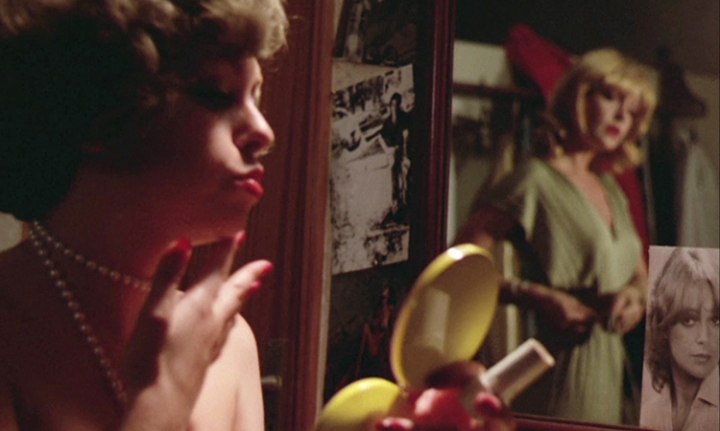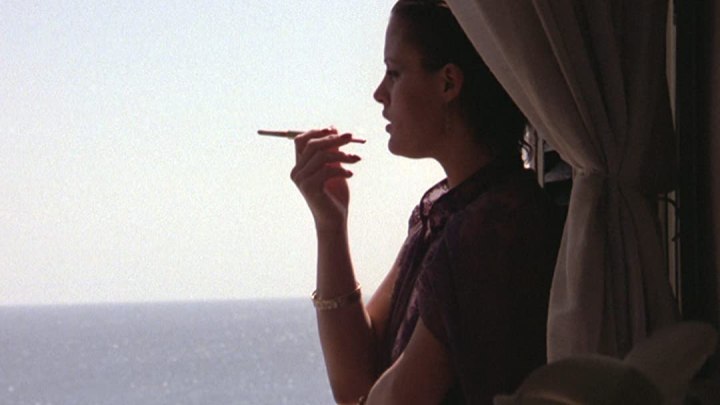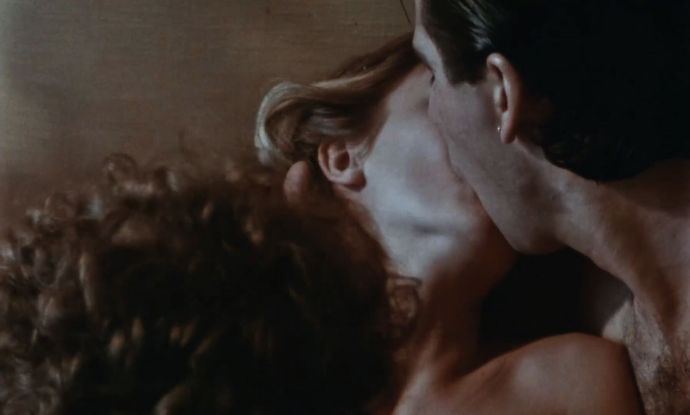Franco spent much of the sixties and the majority of the seventies pushing boundaries with money acquired from international sources, making films that would have been impossible in his native Spain at that time. The death of his namesake General Franco and subsequent relaxation of censorship went some way towards paving the way for a homecoming, as did the end of his productive partnership with Erwin Dietrich. The death of Robert DeNesle may also have contributed, as his Comptoir Francais had been one of the directors principle sources of funding in the early to mid-seventies. Whatever the relative weight of these factors, the director returned to his homeland as the decade drew to a close, initiating a new chapter in so doing.
The first film he completed on his return to Spain was Ópalo de Fuego (1979), a genre-bending crime caper in which two strippers become embroiled in a plot to defeat an international sex-trafficking ring. Primarily funded by Madrid’s Triton Films and shot in Las Palmas, it bears some resemblance to the director’s red lips films, but while the leads therein tend to be savvy and sexy, the protagonists here are little more than pawns in a larger game.

Strippers Brigitte (Nadine Pascal) and Cecile (Linda Romay) are granted early release from a penal institution in exchange for a residence at the Flamingo Club, or more pointedly, in exchange for photographs they are to take during their residence. This brings them into the orbit of the Forbes (Joelle Le Quement and Claude Boisson), who it transpires are kidnapping and brainwashing notable women at the behest of a nefarious international crime syndicate . . .
“Is that the best you can do? It’s downright shit.”
Ópalo de Fuego is not a good film by any meaningful measure. It’s difficult to follow, technically weak and tonally all over the place. It’s a comedy built around strippers that’s rarely funny or sexy, that finds time for lengthy performance pieces and schizophrenic bouts of shocking violence. A cynic might argue that it sounds exactly like a Franco film, and it’s unmistakably a Franco film from the first moment to the last. It’s just not a very good one.
To pick holes in the plot risks assigning it an importance it probably doesn’t deserve, given it was likely written quickly to provide a framework around which the director would improvise. It’s not well-handled though, and as with Blue Rita (1976), we get a deluge of exposition in one scene to compensate for inadequate storytelling to that point.
Part of the problem is the comedy, and not just because it tends towards farce and is not really to my taste. Too much time is afforded to the girls’ hijinks at the outset, and that time would have been better spent setting up the narrative. As it is, by the time camp choreographer Milton (Mel Rodrigo) explains to Cecile who is who, who is working with who and who is double-crossing who, the viewer may well have lost interest.

Of course, there are a few relative highlights, the two major nightclub scenes principal among them. While not among Franco’s best, they provide a welcome break from the banality that surrounds them, especially Irina Forbes’ ‘Salome 2000’ number. Having not done much more than make eyes at the audience for the majority of her act, she finishes with a flourish by pulling a severed head into view, holding it to her breast and then shoving it between her legs in a macabre simulation of cunnilingus.
***
Mercifully, a number of the problems mentioned above are addressed in Two Female Spies with Flowered Panties (1980), the Eurocine release which shares the same premise and much of the same footage. It’s not really clear how this variant – I think it’s probably reasonable to call it a variant – came into being, though one imagines that Franco approached Eurocine with regards to the French distribution of Ópalo and revisions were requested at that point. Stephen Thrower has suggested that they were concerned about the cavalier attitude to focus in the original film and more care does seem to have been taken with the new footage, which was filmed later, using different locations and (some) different actors. That was not my reading of the situation though, at least not on first viewing.
“They both look completely stupid.”
Two Female Spies is not a great film either – it’s not even a good film. It is certainly more coherent than its progenitor though, in part because it opens with two newly-shot scenes that help to orientate the viewer. In the first we see the girls in hand-cuffs, being taken to a club and told to perform their act. They’re terrible, but it doesn’t seem to matter. They’re offered their freedom in exchange for a residency at a club in the Canary Islands, or more specifically for the photographs they are to take during their residence. In the second scene we get to see the Forbes in action, as a young woman (Susan Hemingway) is abducted and raped.
It seems to me the Eurocine variant is the more coherent and the more commercial film, if we’re happy to equate sex and violence with commercial appeal. In addition to the aforementioned rape of Hemingway’s character – which plays out with only her cries on the soundtrack and is quite disturbing as a result – we witness the torture and interrogation of Brigitte, which is nowhere to be found in Ópalo. There are a number of new sex scenes featuring the Forbes, which serve aesthetic and narrative functions by increasing both the bare flesh on display and the audience’s understanding of the pairs position in the criminal hierarchy. One of them also provides a classic Franco composition – among the most memorable in the film – with the statuesque Quement naked in a doorway, sun and sea stretching out behind her.
Not all of the changes are for the better though, for instance the aforementioned Salome 2000 number is missing and missed. There are also some narrative missteps, with Brigitte seeming to have forgotten meeting one of police we saw her with in the opening scene, and Milton referring to finding a dead man in Cecile’s closet, which occurs in Ópalo but not Two Female Spies. These are just problems attributable to the incorporation of the new footage, and thus stand in addition to the numerous inherited gaffs.

While Two Female Spies is by far the more tolerable of the two, the wild tonal shifts remain a problem. The director himself has commented that he has never felt bound by the limits of genre, and the maverick in him, the willingness to forge his own path, is part of what makes his work so interesting. Not all ingredients work well together though, especially when they’re thrown together, as they seem to have been here.
I should also acknowledge that the portrayal of Milton, the camp choreographer, is not going to sit well with some. He’s actually one of the most effective characters in the film(s), helping Cecile evade the Forbes at one point and, when she does fall into their clutches, arranging her rescue. His mannerisms are very much ‘of their time’ though, and I can imagine some twenty-first century viewers will choose to be offended.
To make matters, well, stranger, towards the end of Ópalo it is revealed he is not gay at all, but rather some sort of undercover operative. He’s even dubbed by a different actor thereafter to reinforce the point. In Two Female Spies things play out differently, as he seems to abandon his homosexuality in the final scene, as he rides off into the sunset to start a new life with Cecile. Perhaps it was being raped by Brigitte that ‘turned’ him.
***
The footage unique to Two Female Spies was apparently shot in Portugal around the same time as Sinfonia Erotica (1980), a film so different in style and execution one could be forgiven for imagining it to be the work of an entirely different filmmaker.
Martine de Bressac (Lina Romay) returns from a spell in an institution to find that her husband, the Marquis (Armando Borges), has taken a gay lover in her absence. The two men abduct and corrupt a novice nun (Susan Hemingway), ultimately convincing her to help them exploit Martine’s ill-health, to kill her and live off of the inherited fortune . . .
“I can’t feel anything else for him but love. A hopeless love, without illusions.”
Franco aficionado Alain Petit has differentiated the films the director made for art from those he made for commerce, which sounds simplistic when set in those terms but might help us to understand the dramatic differences between the three films discussed herein. Ópalo de Fuego and Two Female Spies are, to varying degrees carefree and careless, while Sinfonia Erotica is a deadly serious tone poem of a film, executed with the utmost care.
By my reckoning it is the director’s fourth ‘direct’ adaptation of the works of DeSade, the fifth if we’re counting Plaisir a Trois, and is probably the most interesting of the four aesthetically. It has a hazy, dreamlike quality which transforms the grand de Bressac estate into a sinister space from which there appears to be no escape. There’s an abstraction to the cinematography, as the camera drifts from the centre of the action to details of the location, as light sources burst like stars or glow like coals. Perhaps more characteristic of Franco, the film is punctuated by lingering shots of the natural world, in this case by shots of flowers, trees, autumn leaves.

Sinfonia Erotica doesn’t look or sound like a typical Franco film, if it’s meaningful to talk in such terms. In addition to the heavily stylised cinematography, it retains its period setting, meaning rooms are lit with candles, characters travel in horse drawn carriages and dress in bonnets, bustles, bloomers. It also features a classical score drawn primarily from the work of Franz Liszt, supplemented by atmospheric – at times atonal – flourishes from director himself. Really, it doesn’t look or sound like an exploitation film for long stretches of time.
Of course, it is a Franco film adapted from the work of the Marquis DeSade, so there is a significant amount of sex and nudity. There are depictions of fellatio and cunnilingus, with the former – interestingly – performed by Flor (Mel Rodrigo), the Marquis’ gay lover. I say ‘interestingly’ because sexual intimacy between men is very rare in Franco’s filmography, indeed I can’t immediately think of another instance of it. It’s common in the work of DeSade though, albeit more as an activity than an identity. True to the spirit of the source, the principles here – male and female – are happy to indulge their carnal desires regardless of the sex of their partners.
“You came back from hell.”
Sinfonia Erotica tends to get lost in Franco’s vast filmography, most likely because it wasn’t made under the auspices of a ‘name’ producer and has historically been difficult to see. It doesn’t have any bankable stars either, which would admittedly have been unusual for a Franco film of this vintage. Those who do appear on screen acquit themselves well though, particularly Romay – billed here as Candice Coster – in the role of a woman on the verge of a nervous breakdown. Often thought of more as an exhibitionist than an actress, she demonstrates her versatility by segueing from her stint as a stripper, from scrambling awkwardly over rocky terrain in a gold bikini, to freaking out under the psychological pressure applied by a sadistic husband. The real star here is Franco though, the writer / director / composer / camera operator, because while Ópalo de Fuego and Two Female Spies could be cited as evidence by his detractors, Sinfonia Erotica makes the case for his admirers.